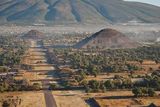Researchers Uncover Ancient Writing System at Teotihuacan

Archaeologists have made a significant breakthrough in understanding the ancient city of Teotihuacan, located in central Mexico, by revealing evidence of a potential writing system that could be over 2,000 years old. A study published in Current Anthropology suggests that the city’s murals and symbols may represent an early form of the Uto-Aztecan language family, which later evolved into Nahuatl, the language of the Aztecs. This discovery implies a direct connection between Teotihuacan and the Aztecs, challenging previous assumptions about their historical timeline.
Deciphering the Murals and Symbols
Previous research has struggled to pinpoint the language and identity of Teotihuacan’s inhabitants, who built one of the largest and most influential cities in ancient Mesoamerica around 100 B.C.E.. At its peak, the city housed more than 100,000 people and served as a major cultural and political center until its decline around 600 A.D.. The study led by Magnus Pharao Hansen, an associate professor at the University of Copenhagen, emphasizes that their method for deciphering the written language is unique, as it combines linguistic analysis with historical context.
“No one before us has used a language that fits the time period to decipher this written language,”
Hansen explained in a press release. He added that their approach establishes a foundational method for future research into Teotihuacan’s texts.
The city’s writing system presents challenges, as its symbols can signify both images and sounds. This duality complicates interpretation, making it difficult to determine when a symbol should be read literally or phonetically. To tackle this, researchers are reconstructing an earlier form of Nahuatl, which they believe the script captures.
The Significance of the Findings
Teotihuacan’s distinct art and architecture, from its grand temples to intricate murals, have been a subject of fascination for historians and archaeologists alike. The murals often display influences from other Mesoamerican cultures, yet their exact linguistic connections have remained elusive.
The researchers have noted that while they currently lack a wealth of texts for analysis, ongoing excavations may yield more artifacts in the future. Hansen remarked, “In Teotihuacan, you can still find pottery with text on it, and we know that more murals will turn up. It is clearly a limitation to our research that we do not have more texts.”
International experts are beginning to take notice of the study, which may pave the way for a deeper understanding of early writing systems in Mesoamerica. Plans are underway for collaborative workshops where researchers will refine their methods and share insights with colleagues globally.
“If we are right, it is not only remarkable that we have deciphered a writing system,”
said Christopher Helmke, another co-author of the study and fellow associate professor at the University of Copenhagen. He emphasized that these findings could reshape our understanding of Mesoamerican cultures and help resolve the long-standing mystery surrounding the inhabitants of Teotihuacan.
This groundbreaking research not only illuminates the linguistic heritage of ancient Mesoamerica but also highlights the potential for future discoveries that could enhance our comprehension of early civilizations in the region.






